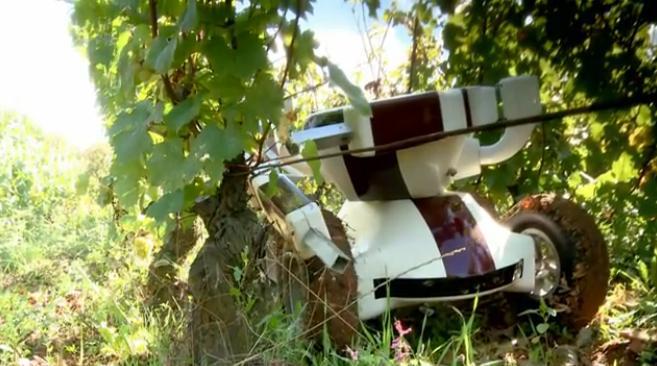Every Friday, Future Tense rounds up the best robot videos of the week. Seen a great robot video? Tweet it to @FutureTenseNow, or email us.
This week, robots take over the highways, lend a hand on French vineyards, and try to keep your plants from dying.
The Wino Bot
Between all the wine tastings and sprawling vistas, the vineyard life must be difficult—so it’s about time robots stepped in to help. Wall-Ye is a prototype robot designed to provide individual care to each vine. As it tours a vineyard, it can build a map, inspect grapes, and prune vines, and Wall-Ye’s inventor Christophe Millot hopes the robot can someday help harvest grapes as well. Over at IEEE Spectrum, Evan Ackerman lists plenty of reasons to be skeptical of this bot’s true utility, but it’s still fun to imagine wine snobs turning their noses at the thought of a robo-Merlot.
Via IEEE Spectrum.
The Sun Spot Bot
If your thumbs, like mine, are not even a little green, a little robot could go a long way. This rover, called the Plant Host Drone, can carry your plants around the house until they are comfortably situated in the sun. Belgian sculptor Stephen Verstraete built the drone with tank treads for mobility and sensors that seek out the highest intensity light in the area. If you’re looking for a project this weekend, Verstraete posted a brief how-to guide on Instructables. Bonus points go to anyone who builds a robotic counterpart that can automatically water the plants as well.
Via Mobile Magazine.
The Road Train
Self-driving cars became legal in California this week, but we’re still nowhere near being able to get behind the wheel and read the paper on the way into work. Perhaps a happy medium is the SARTRE (Safe Road Trains for the Environment) project sponsored by the European Union. The cars in this video form a “road train,” led by a professional driver in a large truck. Each car communicates with the others to determine safe speeds and distances, and from that point on, the drivers are free to do as they wish. Cars can enter and leave the platoon at any point, and switching lanes is no problem (provided other drivers will let five cars merge in front of them). The road trains could save drivers 10 to 20 percent in gas, according to IEEE Spectrum, though they move relatively slowly. Volvo and its partners wrapped up the SARTRE project with this demonstration, but expect to see more great things from this technology in the future.
Via Reuters.
The Mapper Bot
With Google mapping the world beneath the sea and Apple mapping … well, something, you might be wondering when you can embark on your own cartography. Now developers at MIT have taken an automated map-making system—commonly used to help robots get a layout of the world around them—and created a version that humans can wear on their chests. As a user walks around, various sensors on the device detect walls and obstacles to automatically draft a layout of the surroundings, and information can be transmitted immediately to another location. This wearable mapping system could be especially helpful for indoor situations like emergency rescues or military operations, when information is needed fast—and maybe it could even save you $80,000 on those cartography lessons.
Via NBC News.
